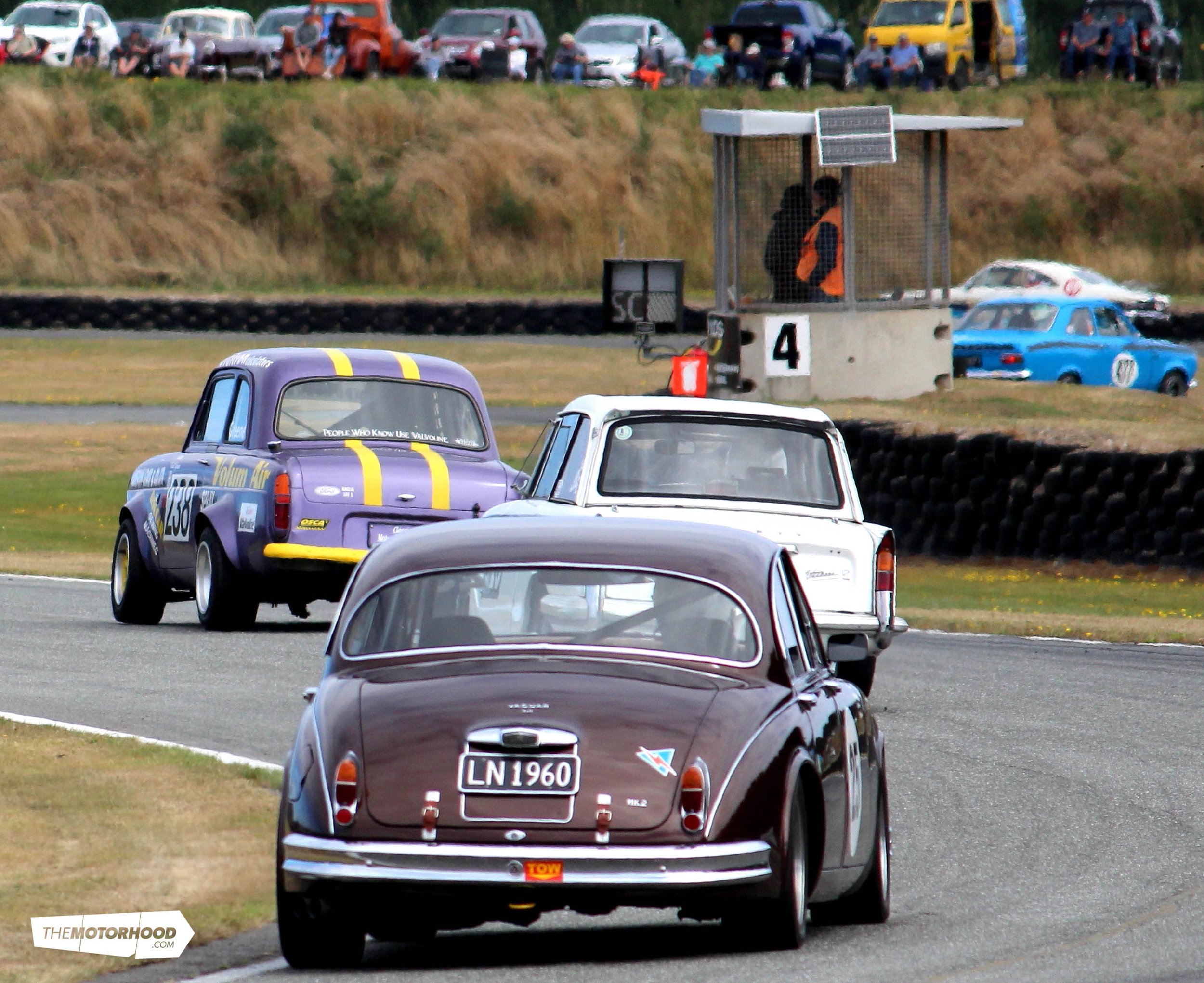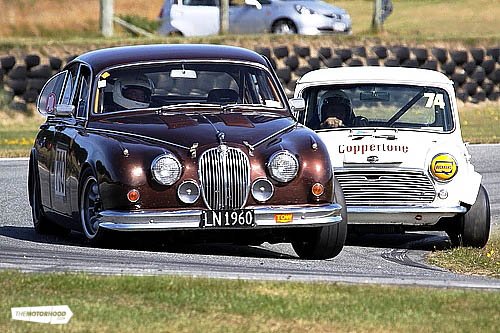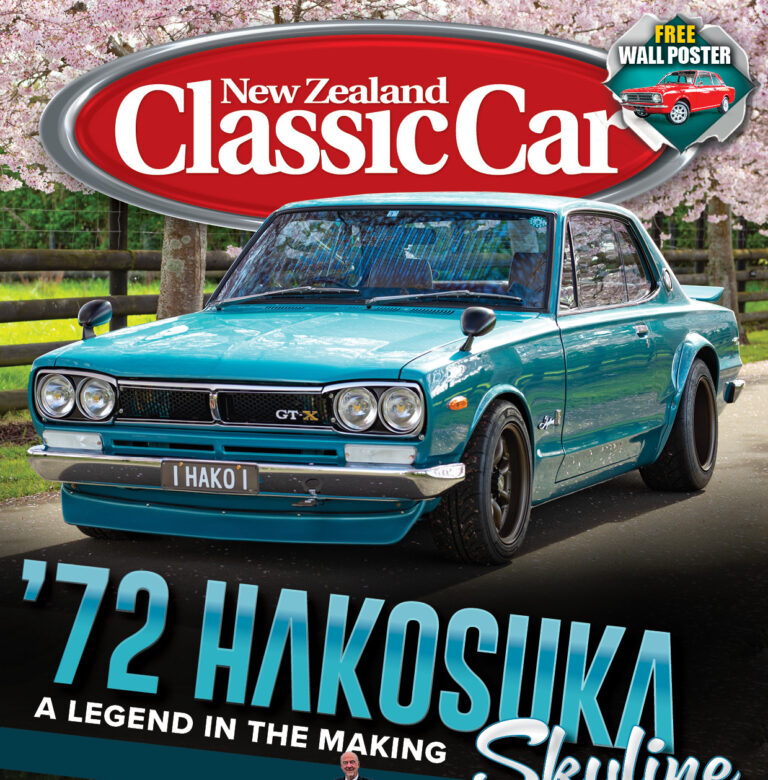Jaguar’s iconic 3.8-litre Mark II saloon provides stunning performance and comfort for four, and its tuneable engine made it a favourite in saloon car races around the world.
By Quinton Taylor, photography Quinton Taylor and Rex Bentham

Jaguar’s distinctive Mark II saloon still impresses today. It was the ’60s favourite of upper-rank business folk, police forces, and bank robbers. It single-handedly created the aura of the British sporting saloon without peer, at a time when few sports cars could equal its performance. It could cruise effortlessly at 100mph (160kph) seemingly indefinitely, or carry on up to more than 125mph (200kph).
Jaguar’s competitors were dumbfounded by its ability to provide leather and walnut luxury in a technically advanced package at such bargain prices. It was Jaguar’s best-selling car from 1959 to 1967 with production reaching nearly 100,000.
Jaguar Mark II’s competition rally and racing track successes were numerous. It tended to be overshadowed by the achievements of Jaguar’s sports models — the C, D, and E — but on the racetrack its power-to-weight ratio meant that until the arrival of the likes of Ford’s Galaxie in 1963, it was a winner the world over. As a collector’s classic, it achieved a reputation of worthwhile investment with solid rising values. It is demanding of its owners, requires deep pockets, preferably a good mechanical knowledge, and perseverance to keep it in top condition. Many owners are hooked and have, over the years, owned a number of examples of what can only be described as a timeless classic saloon of inherent beauty.

Mark II proves its mettle
Along with its sports cars, Jaguar soon discovered a strong appetite for the Mark II both in Europe and the US. Those who helped establish the car’s credentials on the race track in the UK were drivers like Roy Salvadori, Duncan Hamilton, Stirling Moss, and Graham Hill, with the latter pair driving Coombes-prepared cars, which were really full works-backed entries. 1963 was a good year for Jaguar. Denny Hulme and Roy Salvadori won the Brands Hatch 6 Hours while in Europe Peter Nocker won that year’s Touring Car Challenge.
Following successful early efforts in the 1950s with the Jaguar Mark I models many Mark IIs were raced and a similar popularity was enjoyed — albeit on a smaller scale — down under. Jaguar’s legendary XK six-cylinder engine was very tuneable and Browns Lane often willingly supplied many parts to modify its engines and drivetrains. In Australia, Bob Jane raced his famous ‘The Grey Pussy’ 3.4-litre Mark I, and then won the 1962 Australian Touring Car Championship in his 3.8 Mark II, while back in New Zealand, Tony Shelly and Ray Archibald won the Wills Six Hour in their Mark II 3.8 in 1963.

The Cat’s Back — Jaguar Southern Safari
In the ’60s it was not surprising to see up to 10 Mark IIs lining up for the start at motor racing circuits in New Zealand. The familiar roar at the flag drop of Jaguar’s XK6 accompanied by the smell of hot clutches, burning rubber, and burnt avgas was all part of the intense atmosphere and these events attracted big crowds to early saloon car racing. However, times change and many of those familiar cars disappeared over the years, either sold overseas, stored in sheds, or broken up for spares.
Over the past two years a surprising number of Jaguar Mark IIs have re-emerged. Newly rebuilt examples are taking to the track thanks to a strong revival in historic touring car groups throughout the country, with each meeting attracting strong interest from spectators. It’s a trend that has been building for a while and has grown during the past two seasons with the latest group, Historic & Classic Saloons Pre ’78, recently celebrating its first birthday and boasting a membership of over 90 cars from a variety of marques.
One car that has survived and raced regularly despite the odds is Historic and Vintage Racing Association New Zealand (HVRA) member Rex Bentham’s Mark II from Tauranga. This beautifully prepared bronze-coloured Mark II Jaguar survivor toured the South Island classic motor racing events this past season and was a delight to watch and hear as it battled through large fields of classics.
The car is no stranger to southern race tracks thanks to the activities of previous owners. Unfortunately, other Jaguar racing owners were unavailable despite Rex’s best efforts, but he was keen to encourage others from the North Island to join him following the postponement of the Classic GP and tribute to 100 years of Jaguar at Taupō in February. He relished his return trip south: “We thoroughly enjoyed our few weeks in the South Island. There was some very enjoyable motor racing and great camaraderie amongst competitors and we were looked after very well. The car ran faultlessly at all meetings so that was a real plus.


With practice and the Skope Classic postponed in Christchurch we had to find somewhere to store the car and we had no trouble with offers. Great hospitality.” Regrettably, it could well be the only time the Jaguar is back racing in the south in the near future. “I doubt whether we can make it back down again,” says Rex, “it was very enjoyable and great to try out southern racing tracks but it is a big cost and a lot of organising is required to do it.”
Racing cars come and go and few survive. However, this particular car doesn’t only have a well-documented history going back almost 40 years — we are also fortunate to have one of its long-time owners, David Hunter, who is still actively involved in classic motor racing in his MGB GTV8, to help collate LN1960’s history.
Five lives
The history of many racing cars often gets a little blurred over the years, but in this case Rex has helped gather a detailed history of LN1960 following an interview with its original builder, Steve Thomson.
Says Steve, “I think I first heard about LN1960 in 1981. I was told of an old 1960, 3.4 auto sitting in a driveway in Napier. The interior was pretty stuffed but the owner had started a restoration by painting it a nice shade of metallic brown (Ford colour I believe), then he got disheartened and his wife told him to get rid of it. I offered him $1500 and drove it away, not really sure what I was going to do with it, but I could never refuse an old Jag in distress.”Inspiration came after reading an article on one of the rare Coombs-conversion Jaguars. “It looked stunning in red with wire wheels, triple SUs, a louvered bonnet, straight-through exhaust etc.,” Steve recalls. “This gave me the inspiration to build something similar for classic racing.”
He began with a spare 3.8-litre engine that he had in his shed from a Mark IX saloon. It was bored 40-thou oversize, and he used the crankshaft, con rods, sump, and other bits from the 3.4-litre engine in LN1960. A donor XJ6 sedan provided the better-breathing, straight-port cylinder head and he managed to find a set of triple SU HD8 carburettors off a Mark X and fitted them. A standard Moss-type four-speed gearbox was fitted to drive the standard rear differential. The next step was a trip to a Napier panel beater with the bonnet to have it louvered.



“I just gave him a picture of what was needed. He did a fantastic job — and I never got a bill,” says Steve. The Jaguar’s seats were beyond repair but a friend came up with good replacements as well as door cards and the car was finally ready for the track. “I used the car in classic races, mainly Manfeild, Ohakea, and Taupō in the early to mid ’80s. I changed her to wire wheels, which were like tired, old, tennis rackets and which didn’t improve the handling. It never handled as good as on the XJ6 wheels, but it looked cool,” he says. When it was not racing, the Jaguar was used by Steve’s wife Christine as her daily driver, despite its touchy throttle, the notchy Moss gearbox, and a somewhat loud exhaust. It was not ideal family transport so the decision was made to sell it.
Remembers Steve, “The only person who replied to the advert was a larger-than-life character by the name of Mike Westall. He turned up for a test drive, which was bloody terrifying. I didn’t know the old girl could pull 6500rpm in top gear but, as Mike said, if it had blown up it wouldn’t have been suitable for purpose … Anyway, he paid in cash and the car headed off to Auckland.”
A genuine Jaguar enthusiast, Steve has owned some 55 examples of the marque. But he says, “I probably had more fun in LN1960 than any other. It is great to see her still doing what she does best in Rex Bentham’s hands.”
With Mike Westall, the car was always driven with considerable disregard for the laws of physics and it was a regular at the Wellington street race. It was while attending a race meeting at Manfeild that racing driver Mike Uhlenberg took the car for a drive and was hooked. In Uhlenberg’s hands the car was regularly raced until a mishap at the Ngawhini hill-climb wrote off its pristine curves and injured Uhlenberg.
While he was recovering, LN1960 was re-shelled, all the race gear going into the new shell along with a fresh 4.2-litre engine with some added refinements. These included forged pistons, big camshafts, a dry-sump oil supply, triple 45mm Weber carburettors breathing through Chevrolet valves and fired by an electronic ignition and separate coil packs. The engine was rebuilt by Graeme Benjamin of Hawera Automotive with instructions to make it a race engine. The replacement body shell with its larger floor hump for an automatic transmission also meant Mike could install a larger, five-speed Getrag manual gearbox. Underneath, Wilwood four-pot front disc brakes were fitted along with XJS rear discs on a standard Jaguar rear axle. Matching race seats and power steering were added.
Uhlenberg had mainly been involved with speedway for many years although he had owned a number of Jaguars including a couple of 3.8 Mark IIs previously owned by famous Wellington Jaguar racer, tuner, and agent Sybil Lupp. He raced LN1960 for many years around the North Island and won the Sybil Lupp Trophy at the Manfeild Classic in 2000.

Southern Migration
The car’s next owner would be Dunedin-based David Hunter. David raced a Fiat 125T in the South Island and at street races such as Queenstown, Waimate, and Dunedin. He tells how he came to own the Jaguar in 2006: “I saw the car advertised on Trade Me and spoke to the then-owner, Mike Uhlenberg. The car was everything I wanted in a Mark II.” It would be a few race meetings before a recurring engine-oil supply problem was finally resolved and a stint on a chassis dynamometer provided some interesting results.
“We were getting 283bhp [211kW] at the rear wheels at 6000rpm and it was still making power,” he recalls. David then spent a lot of time getting the brake balance right. “In the end, I felt it was a great-handling car, pulled up hard and straight, and could be driven on the throttle. For a car that weighed 1.5 tonnes, with the only lightening being the removal of the heater, the car was always competitive and a front-runner.”
David owned LN1960 for 12 years and raced it regularly — alongside four or five other Jaguars — with few mechanical dramas. “All I did at each meeting was check the oil and water each morning,” he says. “A very enjoyable way to go classic car racing.”
David currently races a very well-presented MGB GTV8 at South Island classic race meetings. The bright red car is an impressive performer. “It’s similar to the Jaguar in many ways and I enjoy it,” he says. The Jaguar was always well maintained and impressive to behold, a tradition current owner Rex Bentham continues.
“I bought the car from David Hunter in June 2015,” says Rex. “David has done some digging into the car’s history and he was sent a large number of photos and some information from Mike Westall’s ownership. I have also been in touch with Mike Uhlenberg, who couldn’t remember exactly when he bought the car but it must have been 25–30 years ago. In Mike’s words the car ‘flew’ and he owned it for about 19 years. David bought the car in 1960 and tidied it up with a partial respray. As you can see, he did a great job.”

A regular racer of Jaguars and MGBs, including a quick Jaguar XK150, Rex is completing the restoration of a second XK150 that he hopes to have displayed at next year’s Taupō Classic Race. In the meantime he is thoroughly enjoying racing LN1960.
“I raced at Hampton Downs [2020] a couple of times, learning a lot each lap — a different driving experience from my previous MGB — but suffered overheating on the last outing,” he says. “Although not related to overheating, we found the engine was in need of more than another refresh so the engine was sent back down to Dunedin’s Bruce Saxton, who did the refresh last time, for a total rebuild. So with any luck the old girl will get a few more laps under her louvered bonnet.”

Thanks to current class regulations LN1960 retains a fitted interior complete with wood trim. This past season the distinctive bronze Jaguar was a big hit with many enthusiasts. The sentiment is best summed up by Historic & Classic Saloons Pre ’78 coordinator Wayne Perkins: “Rex Bentham had an amazing summer of racing: test day at Ruapuna after the Skope Classic was postponed, South Canterbury Hydraulics Classic at Levels Raceway [Timaru International Motor Raceway], Mobil 1 Speedfest at Teretonga Park, Summer Series Round 3 at Manfeild’s Circuit Chris Amon, and finally the Taupō Classic.
No breakages and the ex-Westall Mark II Jaguar performed without any issues, and Rex had a ball. South and North Island, that is commitment. Thank you, Rex. We enjoyed having you and your lovely wife join in the fun and as usual, the Mark II looks as stunning as ever.”

This article originally appeared in NZCC issue No. 382


